300字中秋节英语作文 PPT课件(共11张)
- 格式:ppt
- 大小:58.18 KB
- 文档页数:12
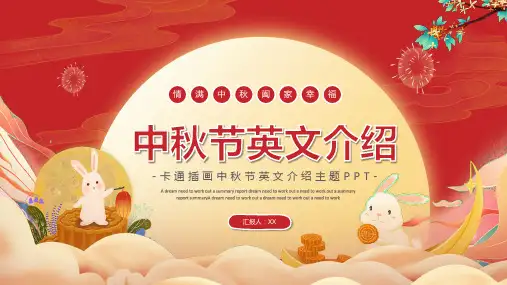

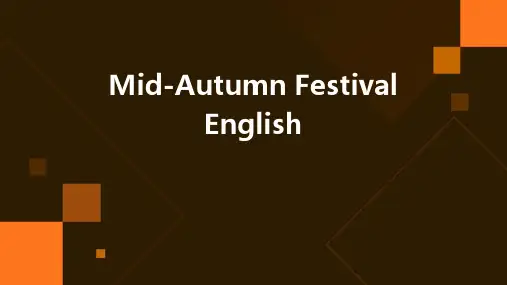
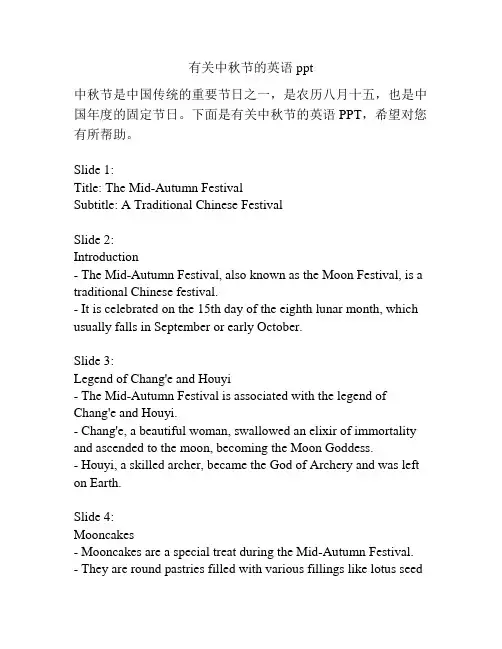
有关中秋节的英语ppt中秋节是中国传统的重要节日之一,是农历八月十五,也是中国年度的固定节日。
下面是有关中秋节的英语PPT,希望对您有所帮助。
Slide 1:Title: The Mid-Autumn FestivalSubtitle: A Traditional Chinese FestivalSlide 2:Introduction- The Mid-Autumn Festival, also known as the Moon Festival, is a traditional Chinese festival.- It is celebrated on the 15th day of the eighth lunar month, which usually falls in September or early October.Slide 3:Legend of Chang'e and Houyi- The Mid-Autumn Festival is associated with the legend of Chang'e and Houyi.- Chang'e, a beautiful woman, swallowed an elixir of immortality and ascended to the moon, becoming the Moon Goddess.- Houyi, a skilled archer, became the God of Archery and was left on Earth.Slide 4:Mooncakes- Mooncakes are a special treat during the Mid-Autumn Festival. - They are round pastries filled with various fillings like lotus seedpaste, red bean paste, or salted egg yolks.- The round shape symbolizes completeness and reunion.Slide 5:Family Reunion- The Mid-Autumn Festival is a time for family reunion.- People often travel back to their hometowns to celebrate with their loved ones.- Families gather together, enjoy a festive meal, and appreciate the full moon while eating mooncakes.Slide 6:Lanterns and Moon Gazing- Lanterns are a prominent feature of the Mid-Autumn Festival. - People light and hang colorful lanterns to create a joyful atmosphere.- Moon gazing is another tradition during this festival. People sit outside and admire the full moon, considering it a symbol of completeness and unity.Slide 7:Customs and Activities- Besides mooncakes, lanterns, and moon gazing, there are other customs and activities during the Mid-Autumn Festival.- People participate in dragon and lion dances, which are believed to bring good luck and ward off evil spirits.- Children carry around colorful lanterns and play traditional games like solving riddles on lanterns.Slide 8:Conclusion- The Mid-Autumn Festival is a time for family reunion, joy, and appreciation of the moon.- It is a significant festival in Chinese culture, with its legends, mooncakes, lanterns, and various customs and activities.- The festival promotes the values of unity, harmony, and gratitude. Slide 9:Thank You!- Any Questions?Note: The content of the slides is just a suggestion, and you can modify it according to your preferences. Additionally, don't forget to use relevant images and graphics to make your presentation engaging.。
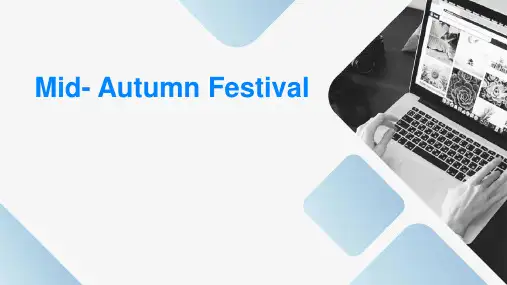
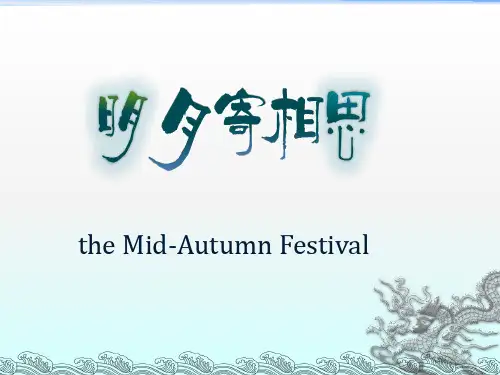
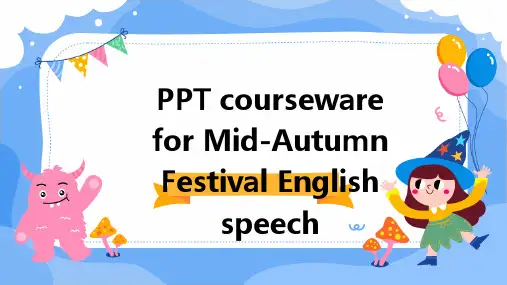
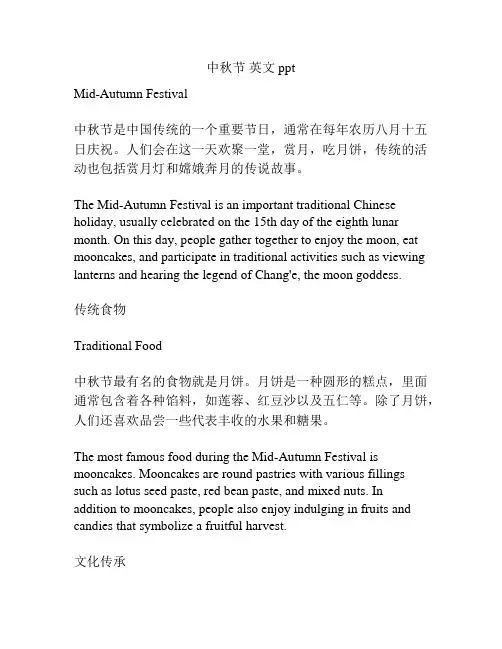
中秋节英文pptMid-Autumn Festival中秋节是中国传统的一个重要节日,通常在每年农历八月十五日庆祝。
人们会在这一天欢聚一堂,赏月,吃月饼,传统的活动也包括赏月灯和嫦娥奔月的传说故事。
The Mid-Autumn Festival is an important traditional Chinese holiday, usually celebrated on the 15th day of the eighth lunar month. On this day, people gather together to enjoy the moon, eat mooncakes, and participate in traditional activities such as viewing lanterns and hearing the legend of Chang'e, the moon goddess.传统食物Traditional Food中秋节最有名的食物就是月饼。
月饼是一种圆形的糕点,里面通常包含着各种馅料,如莲蓉、红豆沙以及五仁等。
除了月饼,人们还喜欢品尝一些代表丰收的水果和糖果。
The most famous food during the Mid-Autumn Festival is mooncakes. Mooncakes are round pastries with various fillings such as lotus seed paste, red bean paste, and mixed nuts. In addition to mooncakes, people also enjoy indulging in fruits and candies that symbolize a fruitful harvest.文化传承Cultural Heritage中秋节是中国传统文化的一部分,人们通过庆祝这个节日来传承和弘扬中华文化。
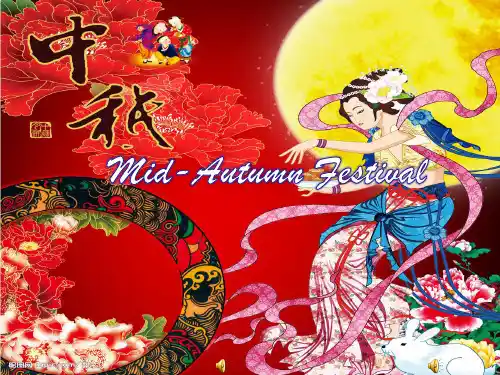
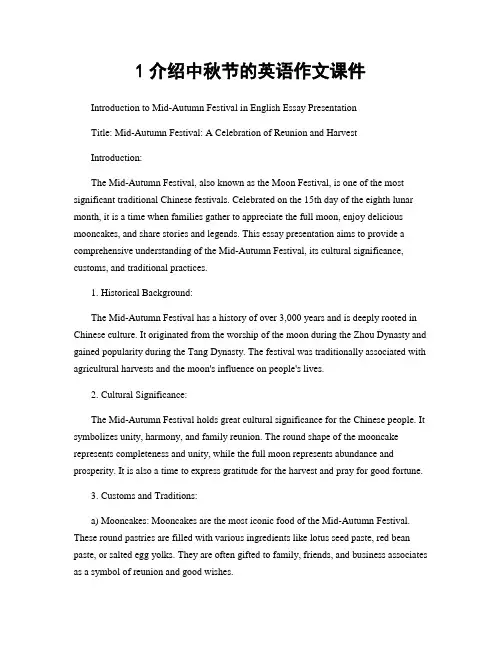
1介绍中秋节的英语作文课件Introduction to Mid-Autumn Festival in English Essay PresentationTitle: Mid-Autumn Festival: A Celebration of Reunion and HarvestIntroduction:The Mid-Autumn Festival, also known as the Moon Festival, is one of the most significant traditional Chinese festivals. Celebrated on the 15th day of the eighth lunar month, it is a time when families gather to appreciate the full moon, enjoy delicious mooncakes, and share stories and legends. This essay presentation aims to provide a comprehensive understanding of the Mid-Autumn Festival, its cultural significance, customs, and traditional practices.1. Historical Background:The Mid-Autumn Festival has a history of over 3,000 years and is deeply rooted in Chinese culture. It originated from the worship of the moon during the Zhou Dynasty and gained popularity during the Tang Dynasty. The festival was traditionally associated with agricultural harvests and the moon's influence on people's lives.2. Cultural Significance:The Mid-Autumn Festival holds great cultural significance for the Chinese people. It symbolizes unity, harmony, and family reunion. The round shape of the mooncake represents completeness and unity, while the full moon represents abundance and prosperity. It is also a time to express gratitude for the harvest and pray for good fortune.3. Customs and Traditions:a) Mooncakes: Mooncakes are the most iconic food of the Mid-Autumn Festival. These round pastries are filled with various ingredients like lotus seed paste, red bean paste, or salted egg yolks. They are often gifted to family, friends, and business associates as a symbol of reunion and good wishes.b) Lanterns: Lanterns play a significant role during the Mid-Autumn Festival. Children and adults alike carry lanterns, often in the shape of animals or characters from folklore, and parade through the streets at night. The vibrant lantern displays create a festive atmosphere and add to the beauty of the moonlit night.c) Moon Gazing: Moon gazing is an essential activity during the Mid-Autumn Festival. Families gather in open spaces, such as gardens or rooftops, to admire the full moon. It is believed that the moon is at its brightest and most beautiful during this time, and it is customary to express wishes for good fortune and happiness.d) Dragon and Lion Dances: Dragon and lion dances are performed during the Mid-Autumn Festival to ward off evil spirits and bring good luck. These lively and colorful performances are accompanied by the rhythmic beats of drums and cymbals, creating an electrifying atmosphere.4. Legends and Stories:a) Chang'e and Houyi: The most famous legend associated with the Mid-Autumn Festival is the story of Chang'e and Houyi. It tells the tale of a beautiful lady who swallowed an elixir of immortality and flew to the moon, where she resides to this day. This legend explains why the moon is worshipped during the festival.b) Wu Gang and the Cherry Bay: Another popular legend is the story of Wu Gang, a woodcutter who was banished to the moon as a punishment for his arrogance. He is doomed to chop down a cherry bay tree, which magically regenerates every time he cuts it. This legend symbolizes the virtue of perseverance.Conclusion:The Mid-Autumn Festival is a cherished cultural tradition that promotes unity, gratitude, and family values. It is a time when people come together to celebrate the harvest, admire the beauty of the moon, and strengthen familial bonds. Through its customs, legends, and significance, the festival showcases the rich heritage and deep-rooted beliefs of the Chinese people. Let us embrace the spirit of the Mid-Autumn Festival and cherish the moments of togetherness it brings.。

中秋节英文介绍1. Introduction to Mid-Autumn FestivalThe Mid-Autumn Festival, also known as the Moon Festival, is a traditional Chinese festival that is celebrated on the 15th day of the 8th month of the lunar calendar. It is a time when family members and friends gather together to appreciate the full moon, eat mooncakes, and enjoy various cultural activities.2. Origins and LegendsThe Mid-Autumn Festival has its origins from ancient times and is deeply rooted in Chinese culture. There are several legends associated with the festival, the most famous of whi ch is the story of Chang’e, the Moon Goddess. According to the legend, Chang’e swallowed the elixir of immortality and floated up to the moon, where she has lived ever since. People believe that on the night of the Mid-Autumn Festival, Chang’e descends to the earth and brings blessings to those who worship her.3. Traditional Customs and Activities3.1 MooncakesMooncakes are a must-have during the Mid-Autumn Festival. These small, round pastries are usually filled with lotus seed paste or red bean paste and contain a salted egg yolk at the center to symbolize the full moon. Mooncakes come in various flavors and designs, and they are often given as gifts to family, friends, and colleagues.3.2 Appreciating the MoonAppreciating the moon is an essential part of the Mid-Autumn Festival. People gather in open spaces, such as parks or rooftops, to admire the full moon and appreciate its beauty. Some may organize moon-watching parties, where traditional music and dances are performed.3.3 Lanterns and Dragon DanceDuring the festival, various lanterns are displayed both indoors and outdoors. These lanterns come in different shapes and sizes, from simple paper lanterns to intricately crafted ones. The Dragon Dance is another popular activity, where a team of performers dances as they manipulate a long, dragon-shaped puppet. It is believed that the dragon brings good luck and wards off evil spirits.3.4 Making and Displaying Zhong KuiZhong Kui is a legendary figure in Chinese folklore who protects people from evil spirits and demons. During the Mid-Autumn Festival, it is a common tradition to make and display Zhong Kui’s image to bring good luck and drive away bad spirits.4. Modern CelebrationsIn addition to the traditional customs, modern celebrations of the Mid-Autumn Festival have evolved over time. Nowadays, people have embraced technology and creativity to celebrate the festival. They use social media platforms to send virtual mooncakes and greetings to their loved ones. Additionally, there are various cultural events, such as lantern exhibitions and music concerts, held during the festival to showcase Chinese traditions and promote cultural exchange.5. ConclusionThe Mid-Autumn Festival is a significant cultural event in China and other Asian countries. It is a time for reunion, reflection, and appreciation of nature’s beauty. Through the celebration of this festival, people share the joy and blessings with their loved ones, and it serves as a reminder of the importance of family and cultural heritage.Remember to mark your calendars for the next Mid-Autumn Festival and join in the festivities to experience this unique celebration firsthand!。
关于中秋节英语作文的课件LessonObjective: Students will learn about the culturalsignificance of the Mid-Autumn Festival and be able to write a descriptive essay in English about it.Slide 1: Introduction- Briefly introduce the Mid-Autumn Festival as a traditional Chinese festival.- Mention the date it is celebrated (15th day of the 8th lunar month).- State the main activities associated with the festival (moon gazing, eating mooncakes, family reunions).Slide 2: Cultural Significance- Explain the importance of the moon in Chinese culture and its connection to the festival.- Discuss the legend of Chang'e, the Moon Goddess, and its relation to the Mid-Autumn Festival.Slide 3: Traditions and Customs- Describe the tradition of lighting lanterns and releasing them into the sky or onto water.- Talk about the custom of eating mooncakes and its symbolism (round shape representing unity and abundance).Slide 4: Family Reunion- Emphasize the importance of family reunion during thefestival.- Discuss how the festival is a time for family members to gather and share meals, stories, and enjoy each other's company.Slide 5: Descriptive Writing Techniques- Introduce students to various descriptive writing techniques (use of sensory details, figurative language, etc.).- Provide examples of how to use these techniques to describe the festival's atmosphere and experiences.Slide 6: Essay Structure- Outline the structure of a descriptive essay (introduction, body, and conclusion).- Guide students on how to organize their thoughts and information about the festival.Slide 7: Vocabulary Building- Provide a list of relevant vocabulary words related to the Mid-Autumn Festival (e.g., mooncake, lantern, reunion, legend).- Encourage students to use these words in their essays.Slide 8: Writing Prompt- Give students a writing prompt: "Describe your perfect Mid-Autumn Festival celebration."- Encourage them to use their imagination and incorporate the cultural elements discussed.Slide 9: Peer Review- Set up a peer review session where students can share their essays with a partner.- Discuss the importance of providing constructive feedback and how to do so.Slide 10: Conclusion- Summarize the key points about the Mid-Autumn Festival and the writing process.- Remind students of the cultural significance of thefestival and the importance of descriptive writing in expressing experiences.Slide 11: Additional Resources- Provide links to websites, videos, or readings for further exploration of the Mid-Autumn Festival.- Suggest additional writing exercises to help improve their descriptive writing skills.Slide 12: Homework Assignment- Assign students to write a descriptive essay based on the lesson and the writing prompt provided.- Specify the length of the essay and any specific requirements (e.g., use of sensory details, inclusion of certain vocabulary).This lesson plan is designed to educate students about the Mid-Autumn Festival while also improving their English descriptive writing skills. By the end of the lesson, students should have a deeper understanding of the festival and be able to craft a well-written essay about it.。